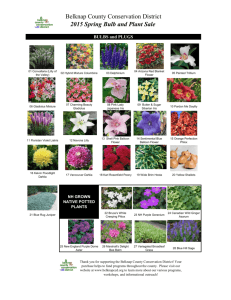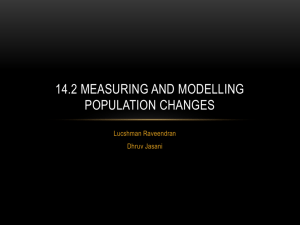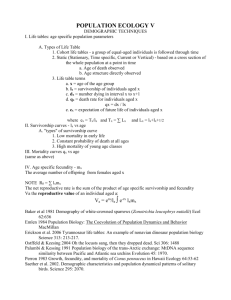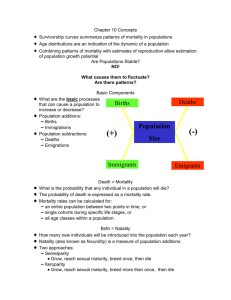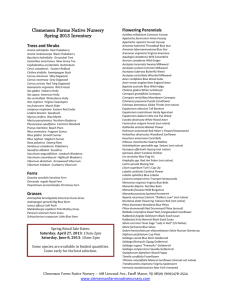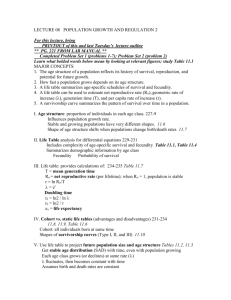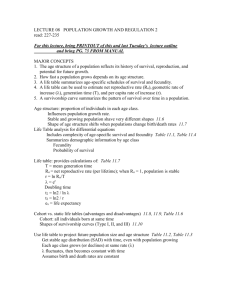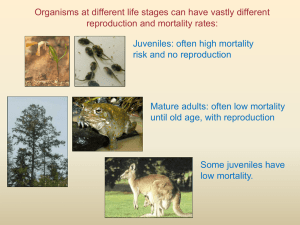Population Ecology:Static and Dynamic I
advertisement
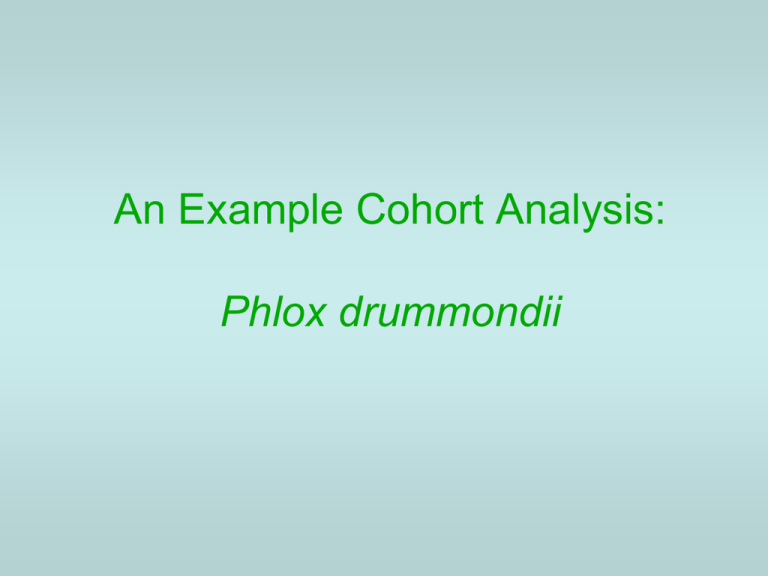
An Example Cohort Analysis: Phlox drummondii Complex survivorship pattern in Euterpe globosa III II I Fecundity Total number of seeds produced by the population Fx Fecundity Total number of seeds produced per individual Fx fx Fx fx Nx Phlox fecundity fx Phlox survivorship and fecundity lx fx Predicting population growth Fx fx f X Average number of offspring produced per individual in absence of mortality x 25.3953 Phlox predicting population growth Fx lxfx = fx lxfx Net Reproductive Value (R0) lxfx R0 Net Reproductive Value (R0) R0 is the number of offspring produced over the lifetime of the average plant, as adjusted by survivorship R0 lx f x Phlox: putting it all together • For the Phlox study R0=2.42 and N0 = 996 • Since Phlox is an annual plant l = R0 • Recall Nt+1 = Ntl • N1 = N0 x 2.42 = 996 x 2.42 = 2407.92 N1 = 2407.92 Life-table approach to cohort analysis The same life table approach can be applied to cohorts of longer lived plants. Cohort Analysis Advantage • Precise knowledge of birth and death rates • Precise knowledge of age Disadvantages • Individuals may live too long to track • Different histories among cohorts may influence birth and death rates Differences among Cohorts: Fecundity in a Desert Winter Annual El Niño Events Differences among Cohorts: Population Size in a Desert Winter Annual Static or Vertical Analysis The Method • Locate a large number of individuals • Classify individuals -- Age -- Size Vertical Analysis of Eastern Hemlock (Heck and Loucks 1976) Size classification Age Classification Size vs. Age in Larrea Tridentata (creosote bush) Size Predict age from size Age Size vs. Age in Larrea Tridentata (creosote bush) Sources of error in estimate • Environmental heterogeneity • Genetic variability • Random events Size as a predictor of fecundity Size as demographic predictor for plants • Often a better predictor than age • Easier to estimate than age Static or Vertical Analysis The Method • Locate a large number of individuals • Classify individuals • Infer rates of mortality and fecundity Models of Mortality for Eastern Hemlock Constant rate of mortality over time Explains 36% of Variance y is the number of plants in each age class Models of Mortality for Eastern Hemlock Declining mortality over time Explains 49% of Variance y is the number of plants in each age class Models of Mortality for Eastern Hemlock Declining mortality with an underlying periodicity Explains 81% of Variance y is the number of plants in each age class Static/Vertical Analysis Advantage (vs. cohort analysis) • Study can be conducted in one fell swoop Disadvantage (vs. cohort analysis) • A large number of assumptions must be made in calculating fecundity or mortality as a function of size or age Stage Based Approaches to Demographic Analysis Phlox: a simple example Step #1: Determine stages to include Seed Juvenile Adult Phlox: a simple example Step #2: Determine transitions to include Seed Juvenile Adult Phlox: a simple example Step #3: Determine parameters to calculate F13 Seed1 P21 Juvenile2 P32 Adult3 Phlox: a simple example Step #4: Collect raw data F13 Seed1 P21 Juvenile2 P32 Adult3 Source of stage data Seed stage Juvenile stage Adult stage Source of stage data Seed stage Juvenile stage Adult stage Phlox: a simple example Step #4: Collect raw data Total number of seeds produced by adults F13 2407.92 Seed1 996 Raw data P21 Juvenile2 190 P32 Adult3 158 Number of individuals in the next generation N0 Seeds produced = R0N0 = 2407.92 R0 Phlox: a simple example Step #4: Calculate transition values P32 F13 2407.92 Seed1 996 190 P21 .19 996 P21 Juvenile2 P32 190 2407.92 15.24 158 Adult3 158 P32 158 .83 190 Phlox: a simple example Step #5: Test and use model 15.24 2407.92 Seed1 .19 996 Juvenile2 .83 190 R0 2407.92 2.417 0.19 * 0.83 *15.24 996 Adult3 158 Complex Life Histories: Argyroxiphium sandwicense A Long-lived Perennial Complex Life Histories: Argyroxiphium sandwicense A Long-lived Perennial Complex Life Histories: A Cryptic Orchid as an Example Cypripedium acaule
